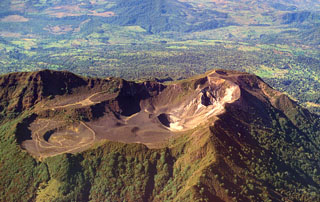Report on Turrialba (Costa Rica) — 30 January-5 February 2019
Smithsonian Institution / US Geological Survey
Weekly Volcanic Activity Report, 30 January-5 February 2019
Managing Editor: Sally Sennert.
Please cite this report as:
Global Volcanism Program, 2019. Report on Turrialba (Costa Rica) (Sennert, S, ed.). Weekly Volcanic Activity Report, 30 January-5 February 2019. Smithsonian Institution and US Geological Survey.
Turrialba
Costa Rica
10.025°N, 83.767°W; summit elev. 3340 m
All times are local (unless otherwise noted)
OVSICORI-UNA reported that minor, sporadic ash emissions that rose to low heights above Turrialba’s active crater were recorded on most days during 28 January-4 February. An event at 0640 on 1 February produced a taller plume which rose 1.5 km above the crater rim and drifted NW.
OVSICORI-UNA noted that activity had been slowly decreasing in 2019. No volcano-tectonic earthquakes had been recorded, and tremors were decreasing in both energy and duration. The number of low-frequency, volcanic earthquakes (LPs) remained stable, although they had decreasing amplitudes. No explosions had been recorded, and emissions were weak, had short durations, and very dilute ash contents.
Geological Summary. Turrialba, the easternmost of Costa Rica's Holocene volcanoes, is a large vegetated basaltic-to-dacitic stratovolcano located across a broad saddle NE of Irazú volcano overlooking the city of Cartago. The massive edifice covers an area of 500 km2. Three well-defined craters occur at the upper SW end of a broad 800 x 2200 m summit depression that is breached to the NE. Most activity originated from the summit vent complex, but two pyroclastic cones are located on the SW flank. Five major explosive eruptions have occurred during the past 3500 years. A series of explosive eruptions during the 19th century were sometimes accompanied by pyroclastic flows. Fumarolic activity continues at the central and SW summit craters.
Source: Observatorio Vulcanologico y Sismologico de Costa Rica-Universidad Nacional (OVSICORI-UNA)

